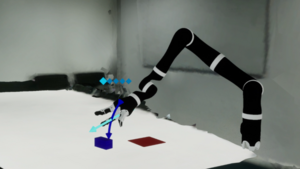Publications
Selected Publications
This page shows selected publications from the last years. For a detailed list please refer to the Google Scholar or DBLP page of Stefan Schneegass.

Type of Publication: Article in Collected Edition
In Time and Space: Towards Usable Adaptive Control for Assistive Robotic Arms
- Author(s):
- Pascher, Max; Kronhardt, Kirill; Goldau, Felix Ferdinand; Frese, Udo; Gerken, Jens
- Title of Anthology:
- RO-MAN 2023 - IEEE International Conference on Robot and Human Interactive Communication
- pages:
- 2300-2307
- Publisher:
- IEEE
- Location(s):
- Busan, Korea
- Publication Date:
- 2023
- Keywords:
- assistive robotics, cooperation and collaboration in human-robot teams, degrees of autonomy and teleoperation
- Digital Object Identifier (DOI):
- doi:10.1109/RO-MAN57019.2023.10309381
- Fulltext:
- In Time and Space: Towards Usable Adaptive Control for Assistive Robotic Arms (1.27 MB)
- Citation:
- Download BibTeX
Abstract
Robotic solutions, in particular robotic arms, are becoming more frequently deployed for close collaboration with humans, for example in manufacturing or domestic care environments. These robotic arms require the user to control several Degrees-of-Freedom (DoFs) to perform tasks, primarily involving grasping and manipulating objects. Standard input devices predominantly have two DoFs, requiring time-consuming and cognitively demanding mode switches to select individual DoFs. Contemporary Adaptive DoF Mapping Controls (ADMCs) have shown to decrease the necessary number of mode switches but were up to now not able to significantly reduce the perceived workload. Users still bear the mental workload of incorporating abstract mode switching into their workflow. We address this by providing feed-forward multimodal feedback using updated recommendations of ADMC, allowing users to visually compare the current and the suggested mapping in real-time. We contrast the effectiveness of two new approaches that a) continuously recommend updated DoF combinations or b) use discrete thresholds between current robot movements and new recommendations. Both are compared in a Virtual Reality (VR) in-person study against a classic control method. Significant results for lowered task completion time, fewer mode switches, and reduced perceived workload conclusively establish that in combination with feedforward, ADMC methods can indeed outperform classic mode switching. A lack of apparent quantitative differences between Continuous and Threshold reveals the importance of user-centered customization options. Including these implications in the development process will improve usability, which is essential for successfully implementing robotic technologies with high user acceptance.
